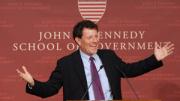“The sense of smell was very poorly understood,” says professor of molecular and cellular biology Catherine Dulac, until a seminal 1991 paper on odorant receptor genes by Linda Buck and Richard Axel (who later shared a Nobel Prize) opened up a huge field for research. In 1992, Dulac earned her doctorate in developmental biology, and the next year left her native France to work with Axel at Columbia University. “Humans and animals can detect hundreds of thousands of ambient chemicals,” Dulac says. “Smell is closely connected with the emotional brain, with pleasure and aversion. And nothing is more evocative of memories than smellthe cookies that grandmother made, or the perfume of someone you just met.” Dulac comes from an academic family in Montpellier (both parents are literature scholars) and graduated from the École Normale Supérieure in Paris. She studies pheromones, chemicals that animals sense (but don’t necessarily smell) that are vehicles for social communicationdefining, for example, potential mates and rivals. So far, evidence doesn’t back “love potion” perfumes containing alleged pheromones, she says. But Senomyx, a company that applies research to improving flavors of foods and medicines, uses scientists like Dulac as advisers. She came to Harvard in 1996, when her department had two tenured women; today there are three. Dulac herself won tenure in only four years. She has run four Boston Marathons, and enjoys travel to places as remote as Patagonia and Easter Island. But conceptual voyageslike extrapolating from mice to humansare trickier. “Humans are very complex,” she explains. “And, especially concerning sex, they lie.”
Catherine Dulac
Catherine Dulac
“The sense of smell was very poorly understood,” says professor of molecular and cellular biology Catherine Dulac, until a seminal...
Explore More From Current Issue

The Trouble with Sidechat
No one feels responsible for what happens on Harvard’s anonymous social media app.

Novelist Lev Grossman on Why Fantasy Isn’t About Escapism
The Magicians author discusses his influences, from Harvard to King Arthur to Tolkien.

Getting to Mars (for Real)
Humans have been dreaming of living on the Red Planet for decades. Harvard researchers are on the case.


